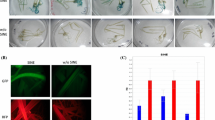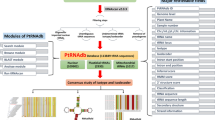Abstract
A comparison of 5′-flanking sequences from 68 different nuclear plant tRNA genes was analyzed to find consensus sequences. Three conserved features stood out, all of which are present in the tRNALeu gene used in this study: (1) a high proportion of A and T residues upstream of all tRNA genes; (2) a region of low duplex stability about 30–35 bp before the coding sequence, often containing a TATA-box like motif; (3) a CAA triplet in the region of the presumed transcription start. The effect of replacement of the AT-rich upstream sequences with GC-rich sequences or unrelated AT-rich sequences was tested by progressive deletions and by inserting randomly cloned sequences upstream of the tRNA gene. GC-rich 5′-flanking sequences were found to be generally incompatible with high levels of expression. The TATA-box like motifs and the CAA triplet were removed or altered by deletion or directed mutagenesis. Mutation of the CAA triplet significantly decreased expression of the tRNALeu gene, suggesting that this CAA triplet is important for transcription efficiency, but mutation or elimination of the TATA-box like motifs generally had little effect. The presence or absence of each of these features in tRNA genes from other organisms is discussed; there are clear and interesting differences between plant tRNA genes and those of yeast and mammals.
Similar content being viewed by others
References
Akama K, Tanifuji S: Sequence analysis of three tRNAPhe nuclear genes and a mutated gene, and one gene for tRNAAla from Arabidopsis thaliana. Plant Mol Biol 15: 337–346 (1990).
Arnold GJ, Gross HJ: Unrelated leader sequences can effi-ciently promote human tRNA gene transcription. Gene 51: 23–46 (1987).
Bradford M: A rapid and sensitive method for the quantitation of microgram quantities of protein utilizing the principle of protein dye binding. Anal Biochem 72: 248–254 (1976).
Breslauer KJ, Frank R, Blöcker H, Marky LA: Predicting DNA duplex stability from the base sequence. Proc Natl Acad Sci USA 83: 3746–3750 (1986).
Bucher P: Weight matrix descriptions of four eukaryotic RNA polymerase II promoter elements derived from 502 unrelated promoter sequences. J Moi Biol 212: 563–578 (1990).
Campbell-Raymond K, Raymond GJ, Johnson JD: In vivo modulation of yeast tRNA gene expression by 50-flanking sequences. EMBO J 4: 2649–2656 (1985).
Carneiro VTC, Pelletier G, Small I: Transfer RNA-mediated suppression of stop codons in protoplasts and transgenic plants. Plant Mol Biol 22: 681–690 (1993).
Choisne N, Martin-Canadell A, Small I: Transactivation of a target gene using a suppressor tRNA in transgenic tobacco plants. Plant J 11: 597–604 (1997).
Chupeau Y, Bourgin JP, Missonier C, Dorion N, Morel G: Préparation et culture de protoplastes de divers Nicotiana. CR Acad Sci Paris 278: 1565–1568 (1974).
DeFranco D, Sharp S, Söll D: Identification of regulatory sequences contained in the 5′-flanking region of Drosophila lysine tRNA2 genes. J Biol Chem 256: 12424–12429 (1981).
Dingermann T, Nerke K, Marschalek R: Influence of different 50-flanking sequences of tRNAgenes on their in vivo transcription efficiencies in Saccharomyces cerevisiae. Eur J Biochem 170: 217–224 (1987).
Fruscoloni P, Zamboni M, Panetta G, De Paolis A, Tocchini-Valentini GP: Mutational analysis of the transcription start site of the yeast tRNALeu3 gene. Nucl Acids Res 23: 2914–2918 (1995).
Fuchs T, Beier D, Beier H: The tRNATyr multigene family of Nicotiana rustica: genome organization, sequence analyses and expression in vitro. Plant Mol Biol 20: 869–878 (1992).
Furter R, Hall BD: Specific transcription and reinitiation of class III genes in wheat embryo nuclei and chromatin. Plant Mol Biol 12: 567–577 (1989).
Gabrielsen OS, Sentenac A: RNA polymerase III (C) factors and its transcription factors. Trends Biochemistry 16: 412–416 (1991).
Geiduschek EP, Tocchini-Valentini GP: Transcription by RNA polymerase III. Annu Rev Biochem 57: 873–914 (1988).
Goffeau A et al.: The yeast genome directory. Nature 387 (suppl.): 1–105 (1997).
Green GA, Maréchal L, Weil JH, Guillemaut P: A Phaseolus vulgaris mitochondrial tRNALeu is identical to its cytoplasmic counterpart: sequencing and in vivo transcription of the gene corresponding to the cytoplasmic tRNALeu. Plant Mol Biol 10: 13–19 (1987).
Guerche P, Bellini C, Lemoullec JM, Caboche M: Use of transient expression assay for the optimization of direct gene transfer into tobacco mesophyll protoplasts by electroporation. Biochimie 69: 621–628 (1987).
Hofmann J, Schumann G, Borschet G, Gosseringer R, Bach M, Bertling WM, Marschalek R, Dingermann T: Transfer RNA genes fromDictyostelium discoideumare frequently associated with repetitive elements and contain consensus boxes in their 5′-and 3′-flanking regions. J Mol Biol 222: 537–552 (1991).
Jefferson RA, Kavanagh TA, Bevan MW: GUS fusions: β-glucuronidase as a sensitive and versatile gene fusion marker in higher plants. EMBO J 6: 3901–3907 (1987).
Joazeiro CAP, Kassavetis GA, Geiduschek EP: Alternative outcomes in assembly of promoter complexes: the roles of TBP and a flexible linker in placing TFIIIB on tRNA genes. Genes Devel 10: 725–739 (1996).
Juo ZS, Chiu TK, Leiberman PM, Baikalov I, Berk AJ, Dickerson RE: How proteins recognize the TATA box. J Mol Biol 261: 239–254 (1996).
Kassavetis GA, Braun BR, Nguyen LH, Geiduschek P: S. cerevisiae TFIIIB is the transcription initiation factor proper of RNApolymerase III, while TFIIIA and TFIIIC are assembly factors. Cell 60: 235–245 (1990).
Kassavetis GA, Joazeiro CAP, Pisano M, Geiduschek EP, Colbert T, Hahn S, Blanco JA: The role of the TATA-binding protein in the assembly and function of themultisubunit yeastRNA polymerase III transcription factor, TFIIIB. Cell 71: 1055–5064 (1992).
Larson D, Bradford-Wilcox J, Young LS, Sprague KU. A short 5′ flanking region containing conserved sequences is required for silkworm alanine tRNA gene activity. Proc Natl Acad Sci USA 80: 3416–3420 (1983).
Maréchal-Drouard L, Weil J, Dietrich A: Transfer RNAs and transfer RNA genes in plants. Annu Rev Plant Physiol 44: 13–32 (1993).
Mukumoto F, Hirose S, Imaseki H, Yamazaki K: DNA sequence requirement of a TATAelement-binding protein from Arabidopsis for transcription in vitro. Plant Mol Biol 23: 995–1003 (1993).
Ow DW, Wood KV, Delucas M, De Wet JR, Helinski DR, Howell SH: Transient and stable expression of the firefly luciferase gene in plant cells and transgenic plants. Science 234: 856–859 (1986).
Palida FA, Hale C, Sprague KU: Transcription of a silkworm tRNAAla(C) gene is directed by twoAT-rich upstreamsequence elements. Nucl Acids Res 21: 5875–5881 (1993).
Reddy PS, Padayatty JD: Effects of 5′ flanking sequences and changes in the 50 internal control region on the transcription of rice tRNAGly gene. Plant Mol Biol 11: 575–583 (1988).
Sajjadi FG, Miller RC, Spiegelman GB: Identification of sequences in the 50 flanking region of a Drosophila melanogaster tRNAVal gene that modulate its transcription in vitro. Mol Gen Genet 206: 279–284 (1987).
Sajjadi FG, Spiegelman GB: Modulation of a Drosophila melanogaster tRNA gene transcription in vitro by a sequence TNNCT in its 5′ flank. Gene 60: 13–19 (1987).
Schaack J, Sharp S, Dingermann T, Johnson-Burke D, Cooley L, Söll D: The extent of a eukaryotic tRNA gene. J Biol Chem 259: 1461–1467 (1984).
Shaw KJ, Olson MV: Effects of altered 5′-flanking sequences on the in vivo expression of a Saccharomyces cerevisiae tRNATyr gene. Mol Cell Biol 4: 657–665 (1984).
Sprague KU: Transcription of eukaryotic tRNA genes. In: Söll D, RajBhandary U (eds) tRNA: Structure, Biosynthesis, and Function, pp. 31–50. American Society for Microbiology, Washington, DC (1995).
Stange N, Beier D, Beier H: Expression of nuclear tRNA' genes from Arabidopsis thaliana in HeLa cell and wheat germ extracts. Plant Mol Biol 16: 865–875 (1991).
Starr DB, Hoopes BC, Hawley DK: DNAbending is an important component of site-specific recognition by the TATAbinding protein. J Mol Biol 250: 434–446 (1995).
Struhl K: Duality of TBP, the universal transcription factor. Science 263: 1103–1104 (1994).
Taneja R, Gopalkrishnan R, Gopinathan KP: Regulation of glycine transfer RNA gene expression in the posterior silk glands of the silkworm Bombyx mori. Proc Natl Acad Sci USA 89: 1070–1074 (1992).
Tapping RI, Syroid DE, Bilan PT, Capone JP: The 50 flanking sequence negatively modulate the in vivo expression and in vitro transcription of a human tRNA gene. Nucl Acids Res 21: 4476–4482 (1993).
Tapping RI, Syroid DE, Capone JP: Upstream interactions of functional mammalian tRNA gene transcription complexes probed using a heterologous DNA-binding protein. J Biol Chem 269: 21812–21819 (1994).
Teichmann T, Urban C, Beier H: The tRNASer isoacceptors and their genes in Nicotiana rustica: genome organization, expression in vitro and sequence analyses. Plant Mol Biol 24: 889–901 (1994).
Ulmasov B, Folk W: Analysis of the role of 5′and 3′flanking sequence elements upon in vivo expression of the plant tRNATrp genes. Plant Cell 7: 1723–1734 (1995).
Wang Y, Jensen RC, Stumph WE: Role of TATAbox sequence and orientation in determining RNA polymerase II/III transcription specificity. Nucl Acids Res 24: 3100–3106 (1996).
Wang Y, Stumph WE: RNA polymerase II/III transcription specificity determined by TATA box orientation. Proc Natl Acad Sci USA 92: 8606–8610 (1995).
Willis IM: RNA polymerase III. Eur J Biochem 212: 1–11 (1993).
Wobbe CR, Struhl K: Yeast and human TATA-binding proteins have nearly identical DNA sequence requirements for transcription in vitro. Mol Cell Biol 10: 3859–3867 (1990).
Wood KV: Novel assay of firefly luciferase providing greater sensitivity and ease of use. J Cell Biol 111: 380A (1990).
Young LS, Takahashi N, Sprague KU: Upstream sequences confer distinctive transcriptional properties on genes encoding silkgland-specific tRNAAla. Proc Natl Acad Sci USA 83: 374–378 (1986).
Zecherle GN, Whelen S, Hall BD: Purines are required at the 5′ends of newly initiated RNAs for optimal RNA polymerase III gene expression. Mol Cell Biol 16: 5801–5810 (1996).
Author information
Authors and Affiliations
Rights and permissions
About this article
Cite this article
Choisne, N., Carneiro, V.T., Pelletier, G. et al. Implication of 5′-flanking sequence elements in expression of a plant tRNALeugene. Plant Mol Biol 36, 113–123 (1998). https://doi.org/10.1023/A:1005988004924
Issue Date:
DOI: https://doi.org/10.1023/A:1005988004924




